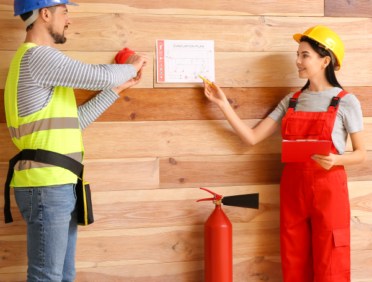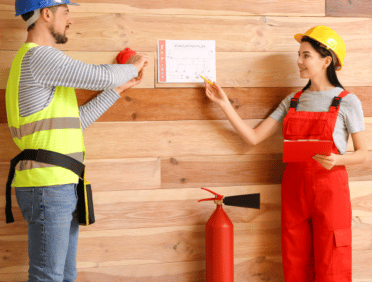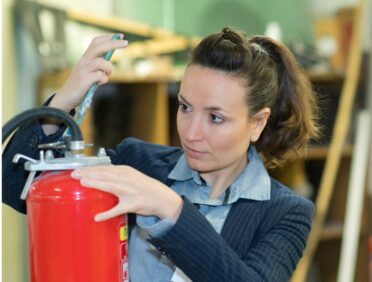Understanding UK Fire Safety
The first place to start when it comes to fire safety is to understand what is meant by fire safety. Why is it important? Why is it significant and what can happen if you do not make fire safety a focus in your workplace?
Legal responsibilities of employers and dutyholders
Employers and duty-holders are responsible for ensuring that they comply with the Fire Safety Order to ensure that fire safety is an important aspect of health and safety in their building. This includes fire protection, fire risk assessments and also having evacuation procedures in place.
The significance of fire safety in the UK workplace
Fires can and do happen, which is the main reason why we need fire safety in the workplace. Fire safety does several things, it reduces the likelihood that fires will start or spread within the building and it also helps to ensure that employees have the confidence to deal with any emergencies that can arise.
Another key part of fire safety is how to ensure that everyone on the premises gets out of the building safely. This means that there needs to be an evacuation plan in place, which ensures that everyone knows what happens during an evacuation and where they need to go in an emergency.
The potential risks and consequences of fire incidents
Several potential risks and consequences come with fire incidents. The first, of course, to keep in mind is how they can harm the lives and health of those who are in the building. This should always be the main focus of fire safety and why you do it.
Of course, other potential risks that can come from a fire incident is the fact that it can damage the premises that it is in and the property and equipment that is within it. This can not only cost you money, but it can also mean that your business has some downtime. Which can impact your long-term earnings.
Promote a culture of vigilance and swift response to potential hazards
Every person in your workplace must be aware of the importance of responding swiftly to any potential hazards within the building. They should always remain vigilant and feel comfortable in being able to highlight any potential risks to the relevant people.
Create a secure work environment through proactive measures
If a risk is identified, either during a risk assessment or by a colleague highlighting it, then you must take action on this. That way, not only do those employees feel that they have been listened to and their thoughts valued, but it also shows that you are doing whatever you can to create a secure work environment for everyone to feel safe within.
Identifying Fire Hazards in the Workplace
The first step in fire safety is taking the time to identify fire hazards within the workplace. By identifying fire hazards, you are going to make sure that you are aware of what can cause a fire, what can help a fire to spread and also what could hinder evacuation efforts too.
Common fire hazards in various workplace settings
The fire hazards that you identify in your business will largely depend on the nature of the work that you do and the type of materials and equipment that you have on-site. That said, there are some common fire hazards that you are likely to see in workplace settings.
These include:
- Electrical equipment that is not maintained or used properly
- Wiring
- Drinks being spilt around equipment
- Cooking appliances left unattended
- Heating equipment
- Human error
Potential ignition sources and combustible materials
As well as identifying the hazards, you should also look at the potential ignition sources within your building too. These are where a fire is most likely to start.
Potential ignition sources are those that will produce heat of some kind. This includes things such as heaters and toasters. Electrical equipment can also be a source of ignition as can damaged cables. You should also look at power sockets as these can be a risk if they are overloaded.
It is also important to look at combustible materials too. These are what can help the fire to get stronger and to spread through the building. The most common form of combustible materials in a workplace is likely to be paper, however, you may also have fabrics, wood and liquids such as white spirit, which can also be combustible.
The importance of proactive hazard identification and mitigation
When it comes to identifying hazards it is vital that you are as proactive as possible. This means that you can pick up on those potential risks and hazards and take action as soon as you can. The main aim should always be to mitigate the hazard and try to reduce the chance of fires occurring, however, this may not always be possible, and you may need to identify this as a risk and be aware of it.
No matter what approach is that you take, being forewarned of the issue is giving you the best chance possible of ensuring that a fire doesn’t spread in your workplace.
Creating a Fire-Safe Work Environment
Creating a fire-safe work environment is an important part of fire safety, it is what helps the entire premises to be as low risk as possible and make people that work and visit there feel as safe as possible.
It also encourages them to ensure that they take responsibility for their environment too.
Proper layout and organisation of workspaces for fire safety
It may not seem like it but tidiness is a key part of fire safety. A workspace that is cluttered and full of a variety of things can very quickly become a risk factor for fire. Not only because the ignition sources are close to flammable materials, but also because it can so easily spread across all of the wealth of materials that are all around the space.
As well as this, a cluttered workspace will often have obstructions, which can make it all the harder for people to escape in the event of a fire. Even more so if they are someone who has limited mobility.
Guidelines for storing flammable substances and hazardous materials
Flammable substances must be stored in a way that ensures that they are as far from ignition sources as possible, this will help to make sure that should a fire start, it will have a much harder time spreading.
Hazardous materials should be stored in the same way, however, you may find it a better idea to store them away from other materials in a locked space too, as this will further prevent fires as well as any other health and safety incidents.
Ensuring adequate ventilation and unobstructed escape routes
We have already looked at fire escape routes a little in the above points, however, it is important to know that no fire routes should be obstructed. They should all be marked too so that people know where to go, even if they are visitors and they don’t usually spend time on your premises.
It is also important that your space is adequately ventilated too, as this can help you to stop the spread of the fire if one was to start.
Fire Prevention Measures and Equipment
Fire prevention measures can come in a variety of types and allow you to try to stop fires from happening and stop them from spreading. The same is true for fire safety equipment, although some of the time these can also be designed to help you to try and extinguish fires if they were to happen.
Selection and installation of fire prevention equipment
Here are some of the most common forms of fire prevention equipment that you can have installed:
- Extinguishers- these are there to help to extinguish the fire, they come in a variety of types and which one you have will depend on which type of fire you are most likely to have on your premises.
- Alarms- alarms, as the name suggests, raise the alarm that there is a fire on the premises and that people need to evacuate
- Blanket- fire blankets are used to smother the fire and starve it of oxygen, therefore putting out the flames
- Sprinkler- sprinklers are usually installed in ceilings and can be triggered when the alarm sounds, they will spray water over the entire space and put out the fire
Maintenance protocols for fire safety devices
Fire safety devices, just like any other form of equipment that you have in your workplace need to be checked and tested regularly. This can help to identify any issues that may occur and find out whether or not there need to be any repairs carried out on them.
These should be performed regularly so that you always know that they are in good working order and that they are going to be ready to use when you need to.
Implementing fire prevention policies and best practices
As well as fire prevention equipment you should also have a policy in place that helps your employees and visitors to understand the fire prevention methods that you have in place. This should cover not only fire prevention but also how to use the equipment that you have in place too.
It should also outline your fire evacuation process too, as this will ensure that everyone knows what they need to do, where they need to go and how best to raise an alarm for an incidence of fire.
Emergency Response Planning
Putting together an emergency response plan is going to help you to make sure that everyone knows what to do if they need to evacuate the building because of a fire.
Developing comprehensive fire emergency plans
You should ensure that developing a comprehensive fire emergency plan is something that you do within your fire safety processes. This should be clear and concise and be easy for every person to understand within the premises. This not only applies to employees but also to visitors too.
Role and responsibilities of fire wardens and marshals
Part of your planning should look at the roles and responsibilities of both the fire wardens and the fire marshals too.
Fire wardens are there to ensure that fire prevention is taken seriously in the workplace, that risks are identified and that steps are taken to try and reduce them where possible.
They also should check over fire protection equipment and make sure that they are working as you would expect them to, that way they are not going to discover that they do not work when faced with a fire.
Fire marshals take a much more reactive role to fire safety, whilst they should be involved in fire prevention and risk assessments, they should be focused on the evacuation of people when there is a suspected fire.
They should know the evacuation process, they should be aware of the places to check for additional people and they should also be aware of whether there are any staff members, or visitors on-site who may require additional support in getting out of the building.
Regular fire drills, training, and simulations for employees
Whilst it is great to have plans written down, the best way to see if an evacuation is going to work is to run a fire drill. This is a practice situation where you act as if there was a fire on the premises and react in the way that you have set out in your plan.
Fire drills will highlight the potential issues that can arise and allow you to fix things so that they will not happen if a real fire was to occur.
It is also recommended to have visuals relevant to fire safety around your place of work to remind people what to do in case of fire.
You can download a FREE In Case of Fire Poster by clicking here and a FREE How to use a Fire Extinguisher Poster by clicking here.
Training is also important for employees, even those who are not acting as a fire marshals or warden. They may only need an overview of fire safety, but having even just the basics can make all the difference should a fire break out.
Evolving Strategies in Fire Safety
Fire safety is ever-growing, with new ways to identify fires and prevent them from happening. It is important that we not only know how fire safety is changing, but that we also embrace these changes too.
Embracing technological advancements for fire detection and prevention
One way that fire safety is changed is in fire detection and prevention. Alarms are becoming smart and can be connected not only to apps and devices that help them to run but also to the rest of your fire prevention system too. This can make it all the easier to raise the alarm and ensure that everyone has the best chance of evacuating from the building.
Continuous improvement through learning from incidents and near misses
We can also change fire safety in our workplaces by looking at the near misses that we may have had, as well as any incidents that have occurred. We can look at what went wrong, what the issues were and also what we may need to change to stop them from happening again.
Whilst it is never good for these things to happen, being able to learn from them is a positive thing.
Adapting strategies to new challenges and regulatory changes
Regulations and laws change, and if this happens we need to be able to adapt our practices to fit these changes. First, we need to ensure that we are aware of what these changes are, and then we need to ascertain how they fit in with the approaches that we already have in place and what may need to change.
Monitoring and Reviewing Fire Safety Measures
To make sure that we are always safe from fire, we need to take the time to monitor and review the fire safety measures that we currently have in place.
Regular audits and assessments of fire safety strategies
The best way to do this is to carry out regular audits and assessments on the fire safety strategies that we have in place. We need to look at whether or not they are fit for purpose and what the possible outcomes could be of these practices. It may be that things need to change to make things safe, but it is best to know this and take action.
Importance of updating plans and policies as needed
Plans and policies are always changing and fire safety is no different. There could be changing within your workplace or changes with the regulations. No matter what happens, you need to ensure that you take the time to update plans and policies that relate to fire safety.
Any changes should also be communicated to your employees so that they are aware of what these are and can ensure that they follow the changes.
Ensuring compliance with evolving fire safety regulations
When safety regulations change, you need to ensure that you change your policies and procedures with them. You should always be compliant with fire safety and the fact that the regulations have changed is not enough of a reason to not be compliant.
Communication and Training
It doesn’t matter whether an employee is part of the fire safety team or not, they should always be a part of the communication and training when it comes to fire safety.
Importance of fire safety awareness among employees
Fire safety awareness helps every single person working within your business be aware of what fire safety looks like. This gives them the information that they need to identify fire risks and take the appropriate action against them.
It also shows that fire safety is everyone’s responsibilty. That everyone should be focused on fire safety and should know what it should look like.
Training programmes and resources available in the UK
There are a variety of training programmes and resources throughout the UK that look at fire safety. These may be in person or they may be online. Both are effective ways of ensuring that every employee in a workplace understands fire safety and can take appropriate action in the case of a fire.
Fire Safety Training
The Regulatory Reform (Fire Safety) Order 2005 (commonly referred to as the Fire Safety Order) requires that employers and building owners ensure that their employees and relevant persons (such as tenants or visitors) are provided with adequate fire safety training.
Learn Q offer a Fire Safety course that is ideal for the majority of employees and other relevant visitors are fully trained and your business is covered, priced at just £20 per learner.
Alternatively, you can save even more with our money saving bundles, which are ideal for large and smaller businesses, such as:
- COSHH and Fire Safety Training Package | £18.74 | includes COSHH Awareness and Fire Safety
- First Aid and Fire Safety Training Package | £17.51 | includes Emergency First Aid at Work and Fire Safety
- First Aid, COSHH and Fire Safety Bundle | £26.24 | includes Emergency First Aid at Work, COSHH Awareness and Fire Safety
- Health and Safety 5 Course Bundle | £40 | includes Fire Safety, Health and Safety at Work, Display Screen Equipment (DSE) Awareness, Slips, Trips and Falls and RIDDOR (Reporting of Injuries, Diseases and Dangerous Occurrences Regulations) Awareness courses
- Health and Safety at Work 7 Course Training Package | £61.25 | includes Fire Safety, Health and Safety at Work, Display Screen Equipment (DSE) Awareness, Emergency First Aid at Work, COSHH Awareness, Manual Handling and Mental Health: Workplace courses
- Health and Safety in Business Training Package | £33.74 | includes Emergency First Aid at Work, COSHH Awareness, Health and Safety at Work and Fire Safety courses
- Health and Safety in Catering Training Package | £34.99 | includes Emergency First Aid at Work, COSHH Awareness, HACCP Awareness and Fire Safety courses












